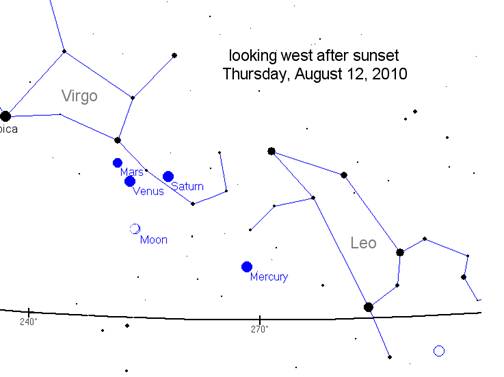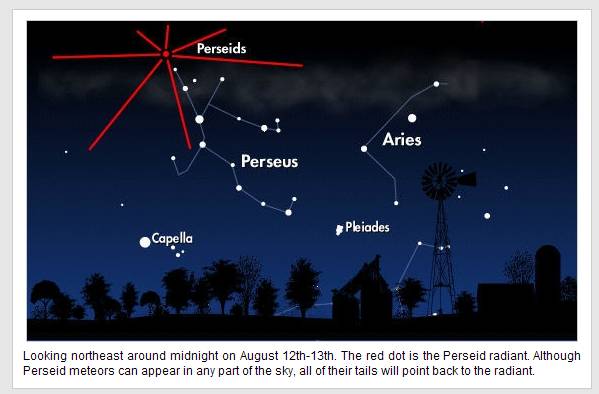Ticker for August 10, 2010
MESONET TICKER ... MESONET TICKER ... MESONET TICKER ... MESONET TICKER ...
August 10, 2010 August 10, 2010 August 10, 2010 August 10, 2010
Time for a shower
Want to see something cool in the sky tonight? It might be tough thanks to all
the rain clouds moving in (HAHAHA!! I crack myself up), but the Perseid meteor
shower starts tonight. This August staple is a must-see for those of the sky-
gazing variety. My educated guess is this event is related to the attacks
perpetrated by the same aliens that aligned all those planets up the last few
weeks.
Just in case I'm wrong, here is some alternate information from Dr. J.D. Carlson
of the Mesonet's OK-FIRE fame:
"Aside from the triangle of planets (Venus, Mars, Saturn) which are still
clearly visible in the WSW after sunset (see diagram below),

there is another important event this week .. the annual Perseid meteor shower.
This year it should be especially good, because for most of the night, the sky
will be without any moon (it sets around 10 p.m.) and thus very dark.
The best hours to watch are thus, after 10 p.m., the nights of Aug. 10, 11, and
12. But the best show will occur between midnight and dawn on the mornings of
Aug. 11, 12, and 13 (peaking the early morning of the 12th).
The meteors (most of them) seem to originate from the constellation Perseus,
which is in the NE sky (thus look to the NE):

Many of these meteors are long-lived and leave long streaks across the sky.
During peak hours, up to 60 or more meteors per hour can be expected. With the
clear skies expected this week, it should be a good show!
For more information on this year?s shower, see:
http://science.nasa.gov/science-news/science-at-nasa/2010/05aug_perseids/
http://www.space.com/spacewatch/perseid-meteor-shower-2010-100806.html
As an interesting side note:
Although the Perseid meteor shower is a delightful and dependable event, its
associated comet is a possible danger to Earth. It is thought to be larger than
the object that likely led to the extinction of the dinosaurs, and it passes
uncomfortably close to Earth.
The comet was discovered in 1862 and last returned in 1992. Computations of
Swift-Tuttle?s orbit indicate that it might come uncomfortably close to Earth
and possibly collide with it. That uncertain event is over 2,000 years in the
future, so there will be plenty of opportunities to observe the Perseids before
things get scary."
So there you have it. I'm not really worried about this comet. I'm betting
the Yellowstone Caldera blows way before then.
Gary McManus
Associate State Climatologist
Oklahoma Climatological Survey
(405) 325-2253
gmcmanus@mesonet.org
August 10 in Mesonet History
| Record | Value | Station | Year |
|---|---|---|---|
| Maximum Temperature | 109°F | GRA2 | 2011 |
| Minimum Temperature | 55°F | EVAX | 2024 |
| Maximum Rainfall | 4.20″ | CHIC | 2017 |
Mesonet records begin in 1994.
Search by Date
If you're a bit off, don't worry, because just like horseshoes, “almost” counts on the Ticker website!